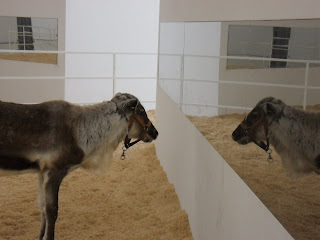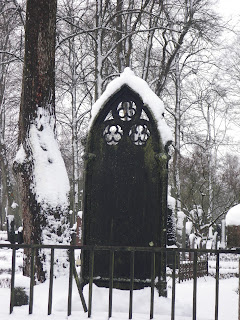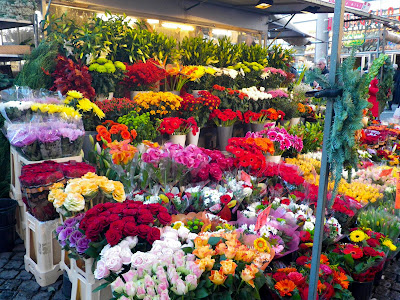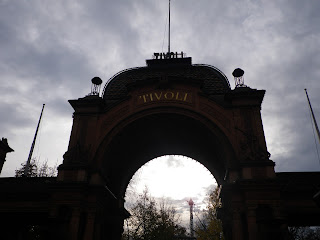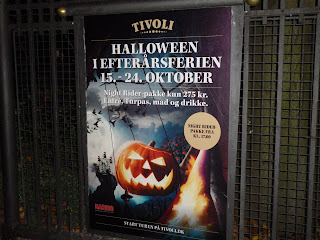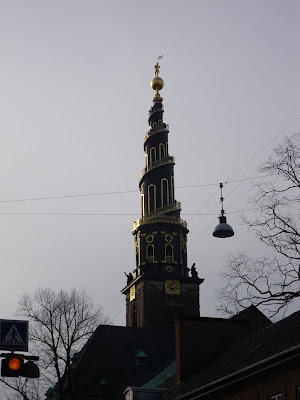So Berlin sometimes looks like a post-apocalyptic wasteland, but it is still full of fun and good times! It's a strange city, it's very modern, but you can still sense the scars of Nazism and Communism. But Berlin did not let authoritarianism keep it down for long, at it's heart, it is a party town.
While I was there, the city was preparing for Christmas. Christmas markets lined all the major streets selling candy, gluhvin (hot spiced wine), hats, and other Christmas paraphernalia. At Alexanderplatz, there was a large carnival with rides. In this area the city had a very festive feeling. In other areas, the city was populated by people who looked as though they might cry at any moment.
Some East German dourness may remain in Berlin, as you can see above, but for the most part the city is very integrated. You cannot tell exactly when you are in the East or West sections of the city, and there is nearly no recognizable impression left from the wall. There is a cultural difference though, in East Berlin many people do not speak English, as they were instead taught Russian as their second language prior to reunification. This was my first time meeting people who didn't speak English in Europe. I was surprised at my own reaction, I felt as though these people should know English, we're in the developed world after all. Being in Europe has made me aware of the privilege of being fluent in English. Thankfully though, my friends Marc and Ina are native German speakers, and they smoothed out any rough translation patches.
Kreuzberg has a large Turkish population, and is home to a Turkish market. I had never eaten Turkish food before, but in Berlin I was exposed to it in a big way. I ate at a certain Turkish bakery half-a-dozen times during my stay, but the bakery was open 24/7 and everything was just a euro. Turkish cuisine was similar to Greek or Lebanese, heavy on feta, spinach, and sesame. Kreuzberg also had a lot of Vietnamese restaurants, a product of Cold War era forced migration from Vietnam to the DDR.
Berlin also has the world's best kebab, called doner locally. I had kebab at one renowned street vendor, and it was delicious, with chicken, grilled vegetables, feta, and two kinds of sauce. Food in Berlin is also fantastically cheap, never once did I spend more than $10 at a meal. (Okay, I did once, but only once.)
The most notable thing about Berlin visually is that there is graffiti everywhere, some simple tags, other elaborate illustrations. A lot of the graffiti or street art is political, above is a "Free Mumia" poster, taking up the case of a death row inmate in Pennsylvania. There is also considerable anti-Nazi graffiti in Kreuzberg, as there are still clashes between Nazi and anti-Nazi street gangs.
Berlin is generally very leftist, and fascism isn't tolerated. However, with increased immigration there is increased nativism. There are two groups of skinheads in Berlin. The first are immigrants from the former USSR who gained German citizenship by claiming it through their great-grandparents. Some of these immigrants have formed street gangs that are anti-Semitic and anti-Turkish. Other skinheads are German nativists, who oppose any immigration or multiculturalism. However, these conflicts weren't visible in day to day life other than through the street art.
The largest collection of street art is the East Side Gallery, which is the largest stretch of the Berlin wall that still remains. They have preserved it as it was in 1989, and the art on the walls dates to that time. If anyone graffitis over the work, it is repainted to its original state. It seems odd in a city of constant change that street art would be preserved, but it is a large part of East Berlin's history.
There were many artists who worked on the wall, and a great variety of styles, but most of the art falls into general themes of philosophy, universal humanism, and parodies of Soviet communism. The above quote seems to be a fitting description of Berlin's restlessness, but it's funny that even on the Berlin wall, writing would be in English.
It's incredible to have as much outdoor art as Berlin does. Walking through the city you are constantly immersed in it. But there is also indoor art.
Here are some reindeer that have been fed magic mushrooms as part of an art project. The artist's intent was "Blah Blah ancient Sanskrit texts, blah blah perception, blah reindeer mice and canaries, blah you can pay 1000 euros to sleep in the stable and drink reindeer pee." In the artists defense, the reindeer pee may contain hallucinogenic properties.
It was supposed to be art as an experiment. Neither the audience nor the artist was informed which group of reindeer was fed the fly agaric mushroom. However, one group of reindeer definitely acted like they were tripping. They were hyperventilating, licking themselves, and staring in the mirror. I wonder if the SPCA would frown on drugging reindeer for art, but apparently the reindeer will also consume the mushroom in the wild when foraging. I thought it was fun to watch the reindeer act silly, but my friend Marc said it wasn't art.
If that wasn't art, this wasn't news. The frontpage story in Berlin was the tale of Flocky, the blind and deaf poodle that was left out in the snow. While this is certainly a sad story, does it really demand front page coverage? And to be shown as a breaking news bulletin on the metro TVs? Berliners love dogs though, and so the tale of Flocky was very much the zeitgeist. Dogs are allowed anywhere in Berlin, on trains, in restaurants, in expensive boutiques. I like it because I think it's fascinating to see dogs in people places, but I cringed when I saw a man hold a terrier in one arm while examining suede shoes. Dogs are great fun, but they will pee indoors.
It wouldn't be a vacation in Germany without some cringing at inappropriate references to the Nazi past, and here at the Mercedes-Benz Christmas display Santa appears to be giving a Heil Hitler salute. Was this accidental? Intentional? Ironic? Offensive? I don't know, but I doubt Santa is a Nazi, he's Jewish!
It was great fun to spend the week preceding Coca-Colamas in Berlin. (The Coca-Cola corporation has bought and reserved all rights to the holiday formerly known as Christmas within German borders.) Now I prepare to spend Christmas in Sweden, my first Christmas away from home.
PS: I learned something funny about German people. Despite their clean reputations, Germans do not shower daily. In fact, Germans only bathe when they perceive themselves to smell. They do this so they may save water, or because they enjoy filth. I now feel that the French are unfairly judged for their hygiene, when it is Germans that are the culprits. I skipped a few showers in Berlin after I noticed I was the only person showering, I wanted to feel a little more German.












